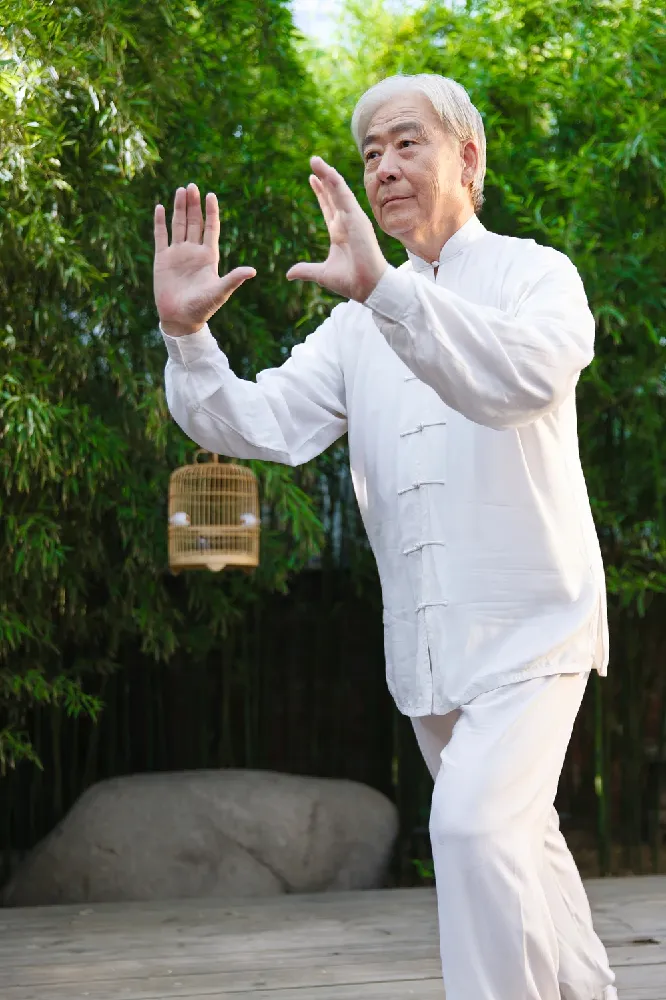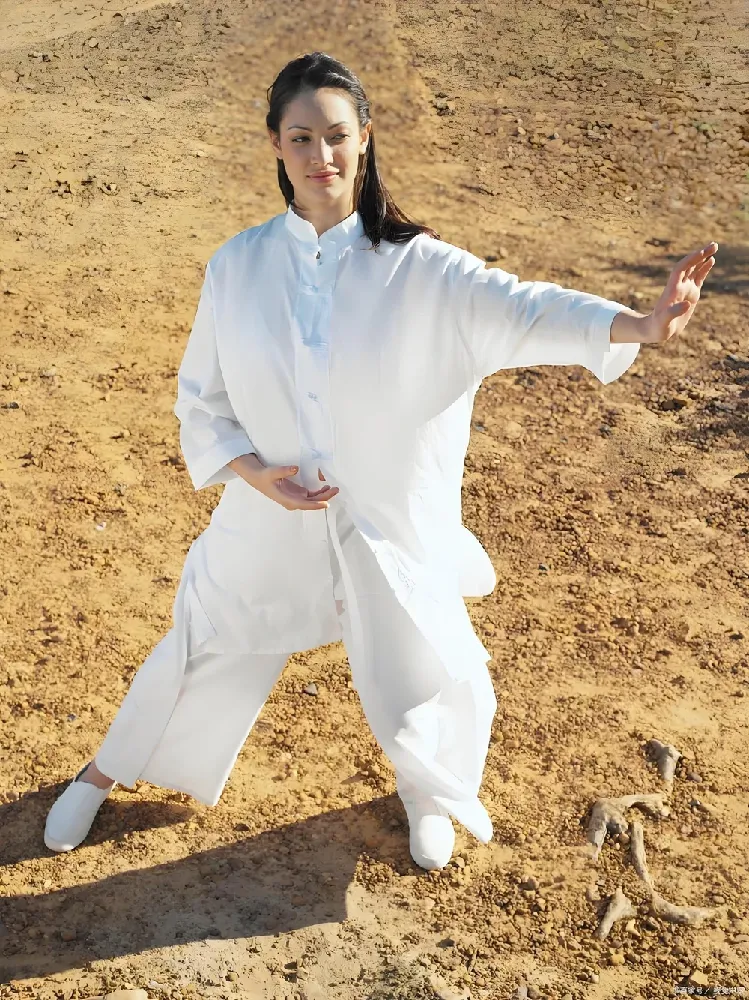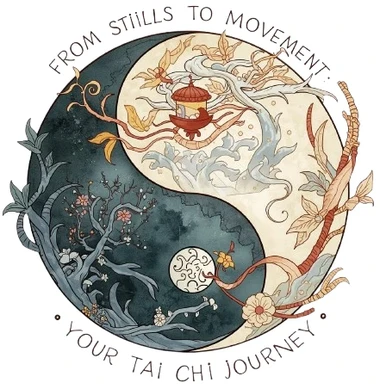The Great Paradox of Tai Chi: Relax to Become Strong
“Relax!”
Your teacher says it again. You nod. You try. But your shoulders creep up. Your jaw tightens. Your breath shortens.
You feel anything but relaxed.
Sound familiar? You’re not alone.
In Tai Chi, “relaxation” is the most misunderstood instruction. It’s also the most essential. Without it, your movements feel stiff. Your energy gets stuck. Your power never arrives.
But here’s the twist: the more you try to relax, the more tense you become.
That’s the paradox. And it’s maddening.
I’ve been there—trying to melt my muscles while secretly clenching everything. Wondering if “relax” just meant “collapse.” Spoiler: it doesn’t.
In this guide, we’ll explore how to relax in Tai Chi—not by going limp, but by unlocking a state called Song. It’s not passive. It’s alive. It’s the key to softness, strength, and flow.
Let’s decode it together.

What Is “Song”—and What It’s Not
Relaxed ≠ Limp
Let’s start with the big one: Song is not floppiness.
- It’s not slouching.
- It’s not collapsing.
- It’s not switching off.
Song is a state of alert relaxation. Your joints open. Your muscles hang naturally. Your breath flows. Your awareness sharpens.
Imagine a garden hose filled with water. It’s soft, but full. Flexible, but connected. That’s Song.
Now imagine a hose with no water. It’s limp. It folds. It disconnects. That’s not Song. That’s collapse.
Exclusive Tip: During practice, ask yourself: “Am I soft or sagging?” If you feel disconnected, gently re-engage your structure.
Song Is the Gateway to Power
In Tai Chi, power doesn’t come from tension. It comes from connection.
When your body is relaxed, energy flows. From the ground, through the legs, into the spine, out the arms. That’s how “Jin” (refined force) is born.
Tension blocks that flow. It’s like stepping on a hose. You can’t force power through a clenched shoulder.
Song opens the gates.
Try this: Stand in Wuji. Breathe. Imagine your joints gently expanding. Feel your weight settle. That’s the beginning of Song.
Song Is a Neuromuscular Skill
You weren’t born knowing how to relax this way. Most of us learned the opposite—tighten to perform. Brace to protect. Clench to control.
Song rewires that.
It’s not just letting go. It’s retraining your nervous system. Teaching your muscles to release while staying ready. It’s subtle. It’s deep. It takes time.
But once you feel it, you’ll never forget it.
Exclusive Tip: Use a mirror. Watch your shoulders. If they lift during movement, pause. Breathe. Let them drop. Repeat until it becomes habit.
The Four Pillars of Relaxation in Tai Chi
So how do we get there? How do we cultivate Song—not just as an idea, but as a feeling?
Here are four pillars that support true relaxation in martial arts.
1. Structural Alignment: Bones Hold, Muscles Rest
Think of your skeleton as a tent frame. When it’s upright, the canvas (your muscles) hangs naturally. No strain. No sag.
In Tai Chi, we use cues like:
- “Lift the crown.”
- “Sink the chest.”
- “Relax the shoulders.”
- “Drop the elbows.”
These aren’t just poetic. They’re biomechanical. They create space. They allow softness.
Try this: Stand tall. Imagine your spine lengthening. Let your arms hang like wet towels. Feel the difference.
Exclusive Tip: Practice “Standing Meditation” with a focus on alignment. Don’t move. Just feel your structure. Let the muscles soften around it.
2. Intentional Awareness: Mind Leads Body
In Tai Chi, intention guides everything. Where your mind goes, your energy follows. Where your energy goes, your body responds.
To relax, you must first intend to relax.
Try a “body scan.” Start at the crown. Move down—eyes, jaw, neck, shoulders, spine, hips, knees, feet. At each point, breathe. Invite softness.
It’s not magic. It’s mindfulness.
Exclusive Tip: Use imagery. Imagine your muscles melting like ice. Your joints opening like flower petals. Your breath flowing like mist.
3. Breath as a Relaxation Catalyst
Breath is your body’s built-in reset button. When you exhale slowly, your nervous system shifts. Your heart rate drops. Your muscles soften. Your mind clears.
In Tai Chi, we use breath to guide relaxation. Not by forcing it—but by following it.
Try this: As you exhale, imagine your shoulders melting. Let your breath sink to your belly. Let your weight settle into your feet.
It’s not just calming. It’s connecting.
Exclusive Tip: Use “sighing breath” during practice. Let the exhale be audible. It signals release. It feels good. It works.
4. Sinking: Relaxation Through Gravity
Song isn’t just softness. It’s depth.
In Tai Chi, we talk about “sinking energy.” It means letting your weight drop—not collapse, but settle. It’s how you root. It’s how you stabilize. It’s how you relax without losing structure.
When your center of gravity lowers, your body finds balance. Your legs engage. Your upper body releases.
It’s the opposite of floating. It’s the feeling of being held by the earth.
Try this: During standing meditation, imagine your breath pulling your weight downward. Let your feet feel heavy. Let your spine stay tall.
Exclusive Tip: Practice “Song of the Knees.” Slightly bend them. Feel the weight shift. Don’t force it. Let it happen.

Releasing Tension: Targeted Relaxation Exercises
Even with good structure and breath, tension hides. In the shoulders. In the hips. In the knees.
Let’s address these trouble spots—gently, intentionally, and with care.
1. Shoulders: The Tension Trap
Shoulders love to lift. Especially when we concentrate. Or try too hard.
To release them, we need awareness and imagery.
Exercise: Stand tall. Imagine your shoulder blades sliding down your back. Draw gentle circles with your elbows. Let the movement come from the scapula—not the arms.
Exclusive Tip: Focus on the “Jing Well” point at the top of the shoulder. Imagine it sinking like a pebble in water.
2. Elbows and Wrists: Softness in the Extremities
Elbows often lock. Wrists often stiffen. Both block flow.
Exercise: Let your elbows point down—not out. Let your wrists hang like tofu. Move slowly. Feel the softness ripple outward.
Exclusive Tip: Imagine your hands floating in warm water. Let the wrists follow the current.
3. Hips and Lower Back: The Forgotten Foundation
Tension in the hips affects everything. It blocks sinking. It tightens the spine. It limits flow.
Exercise: Stand in a wide stance. Gently rock your pelvis forward and back. Find neutral. Then imagine your tailbone dropping like a bell weight.
Exclusive Tip: Practice “Sitting into the Kua.” Bend knees slightly. Let the hips fold. Don’t push—just allow.
4. Knees: The Balance Point
Knees want to lock or collapse. Song lives in between.
Exercise: Stand tall. Bend knees slightly. Not too much. Not too little.
Feel the bounce. Feel the spring.
Exclusive Tip: Think “not straight, not bent.” That’s the sweet spot.
Integrating Song into Movement
Relaxation isn’t static. It flows.
Once you feel Song in stillness, bring it into motion.
Start with a single Tai Chi posture—like “Brush Knee.” Move slowly. Pause often. Scan your body. Where’s the tension? Where’s the softness?
Then connect it to the next move. Let gravity guide you. Let breath support you. Let Song carry you.
Exclusive Tip: Film yourself in slow motion. Watch how your joints open. Where you hold. Where you release.
Conclusion: Relaxation Is a Lifelong Practice
Song isn’t a goal. It’s a journey.
Every time you practice Tai Chi, you’re learning to relax—not by letting go completely, but by letting go wisely.
You’re teaching your body to trust. To soften. To connect.
And that changes everything.
Not just how you move. But how you live.
True relaxation isn’t the absence of effort. It’s the presence of ease. It’s the art of doing less—and feeling more.
Ready to Feel the Difference?
For You: Want expert eyes on your form? Our instructors at the Taichi Academy offer personalized feedback to help you release hidden tension. Start your journey to true relaxation today.
For Your Practice: Download our FREE Relaxation Checklist—a handy guide to remind you of key Song points during your training.
Your softness is your strength. Let’s unlock it—together.
FAQ: Relaxation in Tai Chi—What Song Really Means
What does “Song” mean in Tai Chi?
In Tai Chi, “Song” refers to a state of active relaxation. It’s not limp or collapsed—it’s soft, connected, and alert. Your joints open, your muscles release, and your breath flows. Song allows energy to move freely through the body, making it essential for both power and fluidity.
How is Song different from being limp or weak?
Great question. Limpness lacks structure. Song maintains alignment while releasing tension. Imagine a water-filled hose: flexible but full. That’s Song. A limp hose, on the other hand, folds and disconnects. Song is relaxation with integrity.
Why do I feel more tense when I try to relax?
This is the “relaxation paradox.” Trying too hard activates tension. Instead, use breath, imagery, and awareness to invite softness. Relaxation in martial arts is a skill—not a command. It takes practice to feel natural.
What role does breath play in relaxing during Tai Chi?
Breath is a powerful tool. Slow, deep exhalation activates the parasympathetic nervous system, helping muscles release. In Tai Chi, we often pair breath with movement and intention—like sinking the shoulders on the exhale or guiding energy to the Dantian.
How do I loosen my shoulders for Tai Chi?
Shoulders tend to hold stress. To release them, imagine your shoulder blades sliding down your back. Use circular elbow movements and breath to soften the area. Visualization helps—think of your arms hanging like wet towels.
What is “sinking energy” in Tai Chi?
Sinking energy means letting your weight settle downward—into your feet, into the earth. It’s not collapsing, but grounding. This helps stabilize your posture and deepen relaxation. It’s a key part of Song.
Can Tai Chi help with chronic muscle tension?
Yes. Tai Chi’s slow, mindful movements retrain your nervous system to release habitual tension. Over time, you’ll notice less tightness in common areas like the neck, shoulders, and lower back. It’s especially helpful for stress-related tension.
Is Song only for advanced practitioners?
Not at all. Song is foundational. Beginners can start cultivating it through standing meditation, breath awareness, and simple movements. The key is consistency and patience—it’s a lifelong journey, not a one-time fix.
